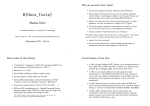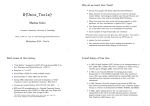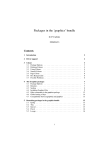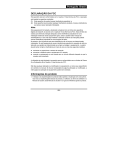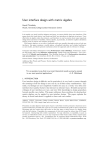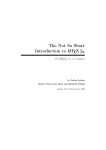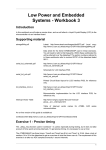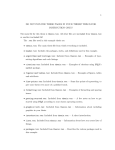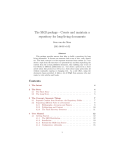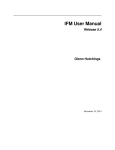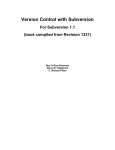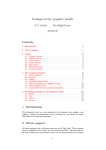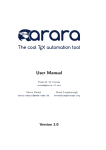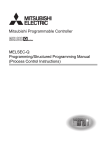Download ${Unix_Tools} - The Computer Laboratory
Transcript
${Unix_Tools}
Markus Kuhn
Computer Laboratory, University of Cambridge
http://www.cl.cam.ac.uk/teaching/1314/UnixTools/
Michaelmas 2013 – Part IB
1
Why do we teach Unix Tools?
I
Second most popular OS family (after Microsoft Windows)
I
Many elements of Unix have became part of common computer
science folklore, terminology & tradition over the past 25 years and
influenced many other systems (including DOS/Windows)
I
Many Unix tools have been ported and become popular on other
platforms: full Unix environment in Apple’s OS X, Cygwin
I
Your future project supervisors and employers are likely to expect
you to be fluent under Unix as a development environment
I
Good examples for high-functionality user interfaces
This short lecture course can only give you a first overview. You need to
spend at least 2–3 times as many hours with e.g. MCS Linux to
I
explore the tools mentioned
I
solve exercises (which often involve reading documentation to
understand important details skipped in the lecture)
2
Brief review of Unix history
I
“First Edition” developed at AT&T Bell Labs during 1968–71 by
Ken Thompson and Dennis Ritchie for a PDP 11
I
Rewritten in C in 1973
I
Sixth Edition (1975) first widely available version
I
Seventh Edition in 1979, UNIX 32V for VAX
I
During 1980s independent continued development at AT&T
(“System V Unix”) and Berkeley University (“BSD Unix”)
I
Commercial variants (Solaris, SCO, HP/UX, AIX, IRIX, . . . )
I
IEEE and ISO standardisation of a Portable Operating System
Interface based on Unix (POSIX) in 1989, later also Single Unix
Specification by X/Open, both merged in 2001
The POSIX standard is freely available online: http://www.unix.org/ and
http://pubs.opengroup.org/onlinepubs/9699919799/
3
A brief history of free Unix
I
In 1983, Richard Stallman (MIT) initiates a free reimplementation of
Unix called GNU (“GNU’s Not Unix”) leading to an editor (emacs),
compiler (gcc), debugger (gdb), and numerous other tools.
I
In 1991, Linus Torvalds (Helsinki CS undergraduate) starts
development of a free POSIX-compatible kernel, later nicknamed
Linux, which was rapidly complemented by existing GNU tools and
contributions from volunteers and industry to form a full Unix
replacement.
I
In 1991, Berkeley University releases a free version of BSD Unix,
after removing remaining proprietary AT&T code. Volunteer projects
emerge to continue its development (FreeBSD, NetBSD, OpenBSD).
I
In 2000, Apple releases Darwin, the now open-source core
components of their OS X and iOS operating systems. Volunteer
projects emerge to port many Unix tools onto Darwin (Homebrew,
Fink, MacPorts, GNU Darwin, etc.).
4
Free software license concepts
I
I
public domain: authors waive all copyright
“MIT/BSD” licences: allow you to copy, redistribute and modify
the software in any way as long as
• you respect the identity and rights of the author
(preserve copyright notice and licence terms in source code and
documentation)
• you agree not sue the author over software quality
(accept exclusion of liability and warranty)
I
GNU General Public Licence (GPL): requires in addition that any
derived work distributed or published
• must be licensed under the terms of the GPL
• must have its source code made publicly available
Numerous refinements and variants of these licences have been written. For more information on
the various opensource licence types and their philosophies: http://opensource.org/
5
Original Unix user interfaces
The initial I/O devices were teletype terminals . . .
Photo: Bell Labs
6
VT100 terminals
. . . and later video display
terminals such as the DEC
VT100, all providing 80
characters-per-line fixed-width
ASCII output. Their
communications protocol is
still used today in graphical
windowing environments via
“terminal emulators” (e.g.,
xterm, konsole).
Photo: http://www.catb.org/esr/writings/taouu/html/
The VT100 was the first video terminal with microprocessor, and the first
to implement the ANSI X3.64 (= ECMA-48) control functions. For
instance, “ESC[7m” activates inverse mode and “ESC[0m” returns to
normal, where ESC is the ASCII “escape” control character (27 = 0x1B).
http://www.vt100.net/
http://www.ecma-international.org/publications/standards/Ecma-048.htm
man console_codes
7
Unix tools design philosophy
I
Compact and concise input syntax, making full use of ASCII
repertoire to minimise keystrokes
I
Output format should be simple and easily usable as input for other
programs
I
Programs can be joined together in “pipes” and “scripts” to solve
more complex problems
I
Each tool originally performed a simple single function
I
Prefer reusing existing tools with minor extension to rewriting a new
tool from scratch
I
The main user-interface software (“shell”) is a normal replaceable
program without special privileges
I
Support for automating routine tasks
Brian W. Kernighan, Rob Pike: The Unix Programming Environment. Prentice-Hall, 1984.
8
Unix documentation
Most Unix documentation can be read from the command line.
Classic manual sections: user commands (1), system calls (2), library
functions (3), devices (4), file formats (5).
I
The man tool searches for the manual page file (→ $MANPATH) and
activates two further tools (nroff text formatter and more text-file
viewer). Add optional section number to disambiguate:
$ man 3 printf
# C subroutine, not command
Honesty in documentation: Unix manual pages traditionally include a BUGS section.
I
xman: X11 GUI variant, offers a table of contents
I
info: alternative GNU hypertext documentation system
Invoke with info from the shell of with C-h i from emacs. Use M(enu) key to select topic or
[Enter] to select hyperlink under cursor, N(ext)/P(rev)/U(p)/D(irectory) to navigate
document tree, Emacs search function (Ctrl-S), and finally Q(uit).
I
Check /usr/share/doc/ and Web for further documentation.
9
Examples of Unix tools
man, apropos, xman, info
help/documentation browser
more, less
plaintext file viewer
ls, find
list/traverse directories, search
cp, mv, rm, touch, ln
copy, move/rename, remove, renew
files, link/shortcut files
mkdir, rmdir
make/remove directories
cat, dd, head, tail
concatenate/split files
du, df, quota, rquota
examine disk space used and free
ps, top, free, uptime, w
process table and system load
vi, emacs, pico
interactive editors
cc, gcc
C compilers
make
project builder
cmp, diff, patch
compare files, apply patches
rcs, cvs, svn, git, hg, bzr
revision control systems
adb, gdb
debuggers
awk, perl, python, tcl
scripting languages
m4, cpp
macro processors
sed, tr
edit streams, replace characters
sort, grep, cut
sort/search lines of text, extract
columns
nroff, troff, tex, latex
text formatters
mail, pine, mh, exmh, elm
electronic mail user agents
10
Examples of Unix tools (cont’d)
telnet, ftp, rlogin, finger,
talk, ping, traceroute, wget,
curl, ssh, scp, rsync, hostname,
host, ifconfig, route
network tools
clear, reset
clear screen, reset terminal
stty
configure terminal driver
xv, display, ghostview, acroread
graphics file viewers
xterm
VT100 terminal emulator
tar, cpio, compress, zip, gzip,
bzip2
xfig, tgif, gimp, inkscape
graphics drawing tools
*topnm, pnmto*, [cd]jpeg
graphics format converters
file packaging and compression
echo, cd, pushd, popd, exit,
ulimit, time, history
builtin shell commands
fg, bg, jobs, kill
builtin shell job control
date, xclock
clocks
which, whereis
bc
calculator
passwd
change your password
chmod
change file permissions
lex, yacc, flex, bison
scanner/parser generators
locate command file
11
The Unix shell
I
The user program that Unix starts automatically after a login
I
Allows the user to interactively start, stop, suspend, and resume
other programs and control the access of programs to the terminal
I
Supports automation by executing files of commands (“shell
scripts”), provides programming language constructs (variables,
string expressions, conditional branches, loops, concurrency)
I
Simplifies file selection via keyboard (regular expressions, file name
completion)
I
Simplifies entry of command arguments with editing and history
functions
I
Most common shell (“sh”) developed 1975 by Stephen Bourne,
modern GNU replacement is “bash” (“Bourne-Again SHell”)
12
Unix inter-process communication mechanisms
invocation
return value
command line arguments
sockets
environment variables
current directory
shared memory
files and pipes
Process
standard input/output/error
semaphores
signals
messages
resource limits, umask
priority
execution time
not supported by shell
supported by shell
13
Command-line arguments, return value, environment
A Unix C program is invoked by calling its main() function with:
I
a list of strings argv as an argument
I
a list of strings environ as a predefined global variable
#include <stdio.h>
extern char **environ;
Environment strings have the form
name =value
int main(int argc, char **argv)
{
int i;
printf("Command line arguments:\n");
for (i = 0; i < argc; i++)
puts(argv[i]);
printf("Environment:\n");
for (i = 0; environ[i] != NULL; i++)
puts(environ[i]);
return 0;
}
where name is free of “=”.
Argument argv[0] is usually the
name or path of the program.
Convention: main() == 0 signals
success, other values signal errors
to calling process.
14
File descriptors
Unix processes access files in three steps:
I
Provide kernel in open() or creat() system call a path name and
get in return an integer “file descriptor”.
I
Provide in read(), write(), and seek() system calls an opened
file descriptor along with data.
I
Finally, call close() to release any data structures associated with
an opened file (position pointer, buffers, etc.).
The lsof tool lists the files currently opened by any process. Under Linux, file descriptor lists and
other kernel data can be accessed via the simulated file system mounted under /proc.
As a convention, the shell opens three file descriptors for each process:
I 0 = standard input (for reading the data to be processed)
I
1 = standard output (for the resulting output data)
I
2 = standard error (for error messages)
15
Basic shell syntax – pipes
Start a program and connect the three default file descriptors stdin,
stdout, and stderr to the terminal:
$ command
Connect stdout of command1 to stdin of command2 and stdout of
command2 to stdin of command3 by forming a pipe:
$ command1 | command2 | command3
Also connects terminal to stdin of command1, to stdout of command3, and to stderr of all three.
Note how this function concatenation notation makes the addition of
command arguments somewhat clearer compared to the mathematical
notation command3(command2(command1(arg1), arg2), arg3):
$ ls -la | sort -n -k5 | less
16
Basic shell syntax – sequences
Execute several commands (or entire pipes) in sequence:
$ command1 ; command2 ; command3
For example:
$ date ; host ryath.ds.cam.ac.uk
Thu Oct 31 11:48:22 GMT 2013
ryath.ds.cam.ac.uk has address 131.111.8.223
Conditional execution depending on success of previous command
(as in logic-expression short-cut):
$ make ftest && ./ftest
$ ./ftest || echo 'Test failed!'
Return value 0 for success is interpreted as Boolean value “true”, other return values for problems
or failure as “false”. The trivial tools true and false simply return 0 and 1, respectively.
17
File redirecting – basics
Send stdout to file
$ command >filename
Append stdout to file
$ command >>filename
Send both stdout and stderr to the same file. First redirect stdout to
filename, then redirect stderr (file descriptor 2) to where stdout goes
(target of file descriptor 1 = &1):
$ command >filename 2>&1
Feed stdin from file
$ command <filename
18
File redirecting – advanced
Open other file descriptors for input, output, or both
$ command 0<in 1>out 2>>log 3<auxin 4>auxout 5<>data
“Here Documents” allow us to insert data into shell scripts directly such
that the shell will feed it into a command via standard input. The << is
followed immediately by an end-of-text marker string.
$
>
>
>
tr <<THEEND A-MN-Za-mn-z N-ZA-Mn-za-m
Vs lbh zhfg cbfg n ehqr wbxr ba HFRARG, ebgngr gur
nycunorg ol 13 punenpgref naq nqq n jneavat.
THEEND
Redirecting to or from /dev/tcp/hostname /port will open a TCP
socket connection:
{ echo "GET /~mgk25/iso-paper.c" >&3 ; cat <&3 ; } \
3<>/dev/tcp/www.cl.cam.ac.uk/80
The above example is a bash implementation of a simple web browser. It downloads and displays
the file http://www.cl.cam.ac.uk/~mgk25/iso-paper.c.
Bash’s /dev/tcp/. . . feature is disabled in some Linux distributions (security concerns).
19
Command-line argument conventions
Each program receives from the caller as a parameter an array of strings
(argv). The shell places into the argv parameters the words entered
following the command name, after several preprocessing steps have been
applied first.
$ cp 'Lecture Timetable.pdf' lecture-timetable.pdf
$ mv *.bak old-files/
Command options are by convention single letters prefixed by a hyphen
(“-h”). Unless followed by option parameters, single character flag
options can often be concatenated:
$ ls -l -a -t
$ ls -lat
GNU tools offer alternatively long option names prefixed by two hyphens
(“--help”). Arguments not starting with hyphens are typically
filenames, hostnames, URLs, etc.
$ gcc --version
$ curl --head http://www.cl.cam.ac.uk/
20
Command-line argument conventions (cont’d)
The special option “--” signals in many tools that subsequent words are
arguments, not options. This provides one way to access filenames
starting with a hyphen:
$ rm -- -i
$ rm ./-i
The special filename “-” signals often that standard input/output should
be used instead of a file.
All these are conventions that most – but not all – tools implement
(usually via the getopt library function), so check the respective manual
first.
The shell remains ignorant of these “-” conventions!
http://pubs.opengroup.org/onlinepubs/9699919799/basedefs/V1_chap12.html
21
Shell command-line preprocessing
A number of punctuation characters in a command line are part of the
shell control syntax
| & ; ( ) < >
or can trigger special convenience substitutions before argv is handed
over to the called program:
I brace expansion: {,}
I
tilde expansion: ~
I
parameter expansion: $
I
pathname expansion / filename matching: * ? []
I
quote removal: \ ' "
22
Brace and tilde expansion
Brace expansion
Provides for convenient entry of words with repeated substrings:
$ echo a{b,c,d}e
abe ace ade
$ echo {mgk25,fapp2,rja14}@cam.ac.uk
[email protected] [email protected] [email protected]
$ rm slides.{bak,aux,dvi,log,ps}
This bash extension is not required by the POSIX standard; e.g. Ubuntu Linux /bin/sh lacks it.
Tilde expansion
Provides convenient entry of home directory pathname:
$ echo ~pb ~/Mail/inbox
/home/pb /homes/mgk25/Mail/inbox
The builtin echo command simply outputs argv to stdout and is useful for demonstrating
command-line expansion and for single-line text output in scripts.
23
Parameter and command expansion
Substituted with the values of shell variables
$ OBJFILE=skipjack.o
$ echo ${OBJFILE} ${OBJFILE%.o}.c
skipjack.o skipjack.c
$ echo ${HOME} ${PATH} ${LOGNAME}
/homes/mgk25 /bin:/usr/bin:/usr/local/bin:/usr/X11R6/bin mgk25
or the standard output lines of commands
$ which emacs
/usr/bin/emacs
$ echo $(which emacs)
/usr/bin/emacs
$ ls -l $(which emacs)
-rwxr-xr-x
2 root
system
3471896 Mar 16
2001 /usr/bin/emacs
Shorter alternatives: variables without braces and command substitution
with grave accent (`) or, with older fonts, back quote (‘)
$ echo $OBJFILE
skipjack.o
$ echo `which emacs`
/usr/bin/emacs
24
Pathname expansion
Command-line arguments containing ?, *, or [. . . ] are interpreted as
regular expression patterns and will be substituted with a list of all
matching filenames.
I
? stands for an arbitrary single character
I
* stands for an arbitrary sequence of zero or more characters
I
[. . . ] stands for one character out of a specified set. Use “-” to
specify range of characters and “^” to complement set. Certain
character classes can be named within [:. . . :].
None of the above will match a dot at the start of a filename, which is
the naming convention for hidden files.
Examples:
*.bak [A-Za-z]*.??? [[:alpha:]]* [^A-Z] .??* files/*/*.o
25
Quote removal
Three quotation mechanisms are available to enter the special characters
in command-line arguments without triggering the corresponding shell
substitution:
I
'...' suppresses all special character meanings
I
"..." suppresses all special character meanings, except for
$ \ `
I
\ suppresses all special character meanings for the immediately
following character
Example:
$ echo '$$$' "* * * $HOME * * *" \$HOME
$$$ * * * /homes/mgk25 * * * $HOME
The bash extension $'...' provides access to the full C string quoting syntax. For example
$'\x1b' is the ASCII ESC character.
26
Job control
Start command or entire pipe as a background job, without connecting
stdin to terminal:
$ command &
[1] 4739
$ ./testrun 2>&1 | gzip -9c >results.gz &
[2] 4741
$ ./testrun1 & ./testrun2 & ./testrun3 &
[3] 5106
[4] 5107
[5] 5108
Shell prints both a job number (identifying all processes in pipe) as well
as process ID of last process in pipe. Shell will list all its jobs with the
jobs command, where a + sign marks the last stopped (default) job.
27
Job control (cont’d)
Foreground job: Stdin connected to terminal, shell prompt delayed until
process exits, keyboard signals delivered to this single job.
Background job: Stdin disconnected (read attempt will suspend job),
next shell prompt appears immediately, keyboard signals not delivered,
shell prints notification when job terminates.
Keyboard signals: (keys can be changed with stty tool)
I
Ctrl-C “intr” (SIGINT=2) by default aborts process
I
Ctrl-\ “quit” (SIGQUIT=3) aborts process with core dump
Ctrl-Z “susp” (SIGSTOP=19) suspends process
I
Another important signal (not available via keyboard):
I
SIGKILL=9 destroys process immediately
28
Job control (cont’d)
Job control commands:
I
fg resumes suspended job in foreground
I
bg resumes suspended job in background
I
kill sends signal to job or process
Job control commands accept as arguments
I
process ID
I
% + job number
% + command name
Examples:
I
$ ghostview
[6]+ Stopped
$ bg
$ kill %6
# press Ctrl-Z
ghostview
29
Job control (cont’d)
A few more job control hints
I
kill -9 ... sends SIGKILL to process. Should only be used as a
last resort, if a normal kill (which sends SIGINT) failed, otherwise
program has no chance to clean up resources before it terminates.
I
The jobs command shows only jobs of the current shell, while ps
and top list entire process table. Options for ps differ significantly
between System V and BSD derivatives, check man pages.
I
fg %- or just %- runs previously stopped job in foreground, which
allows you to switch between several programs conveniently.
30
Shell variables
Serve both as variables (of type string) in shell programming as well as
environment variables for communication with programs.
Set variable to value:
variable=value
Note: No whitespace before or after “=” allowed.
Make variable visible to called programs:
export variable
export variable=value
Modify environment variables for one command only:
variable1=value variable2=value command
“set” shows all shell variables
“printenv” shows all (exported) environment variables.
31
Standard environment variables
I
$HOME — Your home directory, also available as “~”.
I
$USER/$LOGNAME — Your login name.
I
$PATH — Colon-separated list of directories in which shell looks for
commands (e.g., “/bin:/usr/bin:/usr/X11R6/bin”).
Should never contain “.”, at least not at beginning. Why?
I
$LD_LIBRARY_PATH — Colon-separated list of directories where the
loader looks for shared libraries (see man ld.so)
I
$LANG, $LC_* — Your “locale”, the name of a system-wide
configuration file with information about your character set and
language/country conventions (e.g., “en_GB.UTF-8”). $LC_* sets
locale only for one category, e.g. $LC_CTYPE for character set and
$LC_COLLATE for sorting order; $LANG sets default for everything.
“locale -a” lists all available locales.
I
$TZ — Specification of your timezone (mainly for remote users)
I
$OLDPWD — Previous working directory, also available as “~-”.
32
Standard environment variables (cont’d)
I
$PS1 — The normal command prompt, e.g.
$ PS1='\[\033[7m\]\u@\h:\W \!\$\[\033[m\] '
mgk25@ramsey:unixtools 12$
I
$PRINTER — The default printer for lpr, lpq and lprm.
I
$TERM — The terminal type (usually xterm or vt100).
I
$PAGER/$EDITOR — The default pager/editor (usually less and
emacs, respectively).
I
$DISPLAY — The X server that X clients shall use.
man 7 environ
33
Executable files and scripts
Many files signal their format in the first few “magic” bytes of the file
content (e.g., 0x7f,'E','L','F' signals the System V Executable and
Linkable Format, which is also used by Linux and Solaris).
The “file” tool identifies hundreds of file formats and some parameters based on a database of
these “magic” bytes:
$ file $(which ls)
/bin/ls: ELF 32-bit LSB executable, Intel 80386
The kernel recognizes files starting with the magic bytes “#!” as
“scripts” that are intended for processing by the interpreter named in the
rest of the line, e.g. a bash script starts with
#!/bin/bash
If the kernel does not recognize a command file format, the shell will
interpret each line of it, therefore, the “#!” is optional for shell scripts.
Use “chmod +x file” and “./file”, or “bash file”.
34
Plain-text files
I
File is a sequence of lines (trad. each < 80 characters long).
I
Characters ASCII encoded (or extension: ISO 8859-1 “Latin 1”,
Microsoft’s CP1252, EUC, Unicode UTF-8, etc.)
I
Each line ends with a special “line feed” control character (LF, Ctrl-J,
byte value: 1010 = 0A16 ).
I
“Horizontal tabulator” (HT, TAB, Ctrl-I, byte value: 9) advances the
position of the next character to the next multiple-of-8 column.
Some systems (e.g., DOS, Windows, some Internet protocols) end each line
instead with a two control-character sequence: “carriage return” (CR, Ctrl-M,
1310 = 0D16 ) plus “line feed”.
Different end-of-line conventions and different ASCII extensions make
conversion of plain-text files necessary (dos2unix, iconv). Very annoying!
Alternative “flowed” plain-text format: no LF is stored inside a paragraph, line wrapping of
paragraph happens only while a file is being displayed, LF terminates paragraph.
Some plain-text editors (e.g., Windows Notepad) start each UTF-8 plain-text file with a Unicode
“Byte Order Mark” (BOM, U+FEFF, EF16 BB16 BF16 ), which is not normally used under Unix.
35
Shell compound commands
A list is a sequence of one or more pipelines separated by “;”, “&”, “&&”
or “||”, and optionally terminated by one of “;”, “&” or end-of-line.
The return value of a list is that of the last command executed.
I
( list ) executes list in a subshell
I
{ list ; } groups a list (to override operator priorities)
I
for variable in words ; do list ; done
Expands words like command-line arguments, assigns one at a time
to the variable, and executes list for each. Example:
for f in *.txt ; do cp $f $f.bak ; done
I
if list ; then list ; elif list ; then list ; else list ; fi
I
while list ; do list ; done
until list ; do list ; done
36
Shell compound commands (cont’d)
I
case word in
pattern|pattern|. . . ) list ;;
...
esac
Matches expanded word against each pattern in turn (same
matching rules as pathname expansion) and executes the
corresponding list when first match is found. Example:
case "$command" in
start)
app_server &
processid=$! ;;
stop)
kill $processid ;;
*)
echo 'unknown command' ;;
esac
37
Boolean tests
The first list in the if, while and until commands is interpreted as a
Boolean condition. The true and false commands return 0 and 1
respectively (note the inverse logic compared to Boolean values in C!).
The builtin command “test expr”, which can also be written as
“[ expr ]” evaluates simple Boolean expressions on files, such as
-e file is true if file exists.
-d file is true if file exists and is a directory.
-f file is true if file exists and is a normal file.
-r file is true if file exists and is readable.
-w file is true if file exists and is writable.
-x file is true if file exists and is executable.
or strings, such as
string1 == string2
string1 != string2
string1 < string2
string1 > string2
38
Boolean tests – examples
if [ -e $HOME/.rhosts ] ; then
echo 'Found ~/.rhosts!' | \
mail $LOGNAME -s 'Hacker backdoor?'
fi
Note: A backslash at the end of a command line causes end-of-line to be ignored.
if [ "`hostname`" == python.cl.cam.ac.uk ] ; then
( sleep 10 ; play ~/sounds/greeting.wav ) &
else
xmessage 'Good Morning, Dave!' &
fi
[ "`arch`" != ix86 ] || { clear ; echo "I'm a PC" ; }
39
Aliases and functions
Aliases allow a string to be substituted for the first word of a command:
$ alias dir='ls -la'
$ dir
Shell functions are defined with “name () { list ; }”. In the function
body, the command-line arguments are available as $1, $2, $3, etc. The
variable $* contains all arguments and $# their number.
$ unalias dir
$ dir () { ls -la $* ; }
Outside the body of a function definition, the variables $*, $#, $1, $2,
$3, . . . can be used to access the command-line arguments passed to a
shell script.
40
Shell history
The shell records commands entered. These can be accessed in various
ways to save keystrokes:
I
“history” outputs all recently entered commands.
I
“!n” is substituted by the n-th history entry.
I
“!!” and “!-1” are equivalent to the previous command.
I
“!*” is the previous command line minus the first word.
I
Use cursor up/down keys to access history list, modify a previous
command and reissue it by pressing Return.
I
Type Ctrl-O instead of Return to issue command from history and
edit its successor, which allows convenient repetition of entire
command sequences.
I
Type Ctrl-R to search string in history.
Most others probably only useful for teletype writers without cursor.
41
Readline
Interactive bash reads commands via the readline line-editor library.
Many Emacs-like control key sequences are supported, such as:
I
Ctrl-A/Ctrl-E moves cursor to start/end of line
I
Ctrl-K deletes (kills) the rest of the line
I
Ctrl-D deletes the character under the cursor
I
Ctrl-W deletes a word (first letter to cursor)
I
Ctrl-Y inserts deleted strings
I
ESC ˆ performs history expansion on current line
I
ESC # turns current line into a comment
Automatic word completion: Type the “Tab” key, and bash will
complete the word you started when it is an existing $variable, ˜user,
hostname, command or filename, depending on the context. If there is an
ambiguity, pressing “Tab” a second time will show list of choices.
42
Startup files for terminal access
When you log in via a terminal line or telnet/rlogin/ssh:
I
After verifying your password, the login command checks
/etc/passwd to find out what shell to start for you.
I
As a login shell, bash will execute the scripts
/etc/profile
~/.profile
The second one is where you can define your own environment. Use
it to set exported variable values and trigger any activity that you
want to happen at each login.
I
Any subsequently started bash will read ~/.bashrc instead, which is
where you can define functions and aliases, which – unlike
environment variables – are not exported to subshells.
43
Startup files for X Window System access
The “X server” provides access to display, keyboard and mouse for “X
client” applications via the “X11 protocol”.
Before login, the only client is the X Display Manager (xdm).
After login, xdm will start the script /usr/lib/X11/xdm/Xsession.
That invokes the “X clients” (xterm, etc.) that run on your desktop by
default. If ~/.xsession exists, this script will be called instead.
Most X clients in Xsession or ~/.xsession are started in background,
except for the last one, which is usually a window manager (twm, fvwm2,
KDE, etc.). When this last client terminates, and with it the Xsession
script, then xdm will reset the X server. This will terminate all X clients
and the user is logged out.
You can configure your login screen in ~/.xsession. You can also
configure default parameters for many X clients via the xrdb command.
See “man X” for details.
44
Typical .xsession file
#!/bin/bash
. ~/.profile
# set X defaults and keymaps
userresources=~/.Xdefaults
usermodmap=~/.Xmodmap
if [ -f $userresources ]; then
xrdb $userresources
fi
if [ -f $usermodmap ]; then
xmodmap $usermodmap
fi
# start some X clients as background processes
xterm -geometry 80x10+10+5 -C -title "`hostname -s` console" \
-bg lightgreen &
xclock -geometry 80x80+0-0 -update 1 &
xload -geometry 80x80+90-0 -nolabel &
# start window manager as foreground process
if [ -x /usr/bin/X11/fvwm2 ] ; then
/usr/bin/X11/fvwm2
else
twm
fi
45
sed – a stream editor
Designed to modify files in one pass and particularly suited for doing
automated on-the-fly edits of text in pipes. sed scripts can be provided
on the command line
sed [-e] 'command' files
or in a separate file
sed -f scriptfile files
General form of a sed command:
[address[,address]][!]command[arguments]
Addresses can be line numbers or regular expressions. Last line is “$”.
One address selects a line, two addresses a line range (specifying start
and end line). All commands are applied in sequence to each line. After
this, the line is printed, unless option -n is used, in which case only the p
command will print a line. The ! negates address match. {. . . } can
group commands per address.
46
sed – regular expressions
Regular expressions enclosed in /. . . /. Some regular expression meta
characters:
I
“.” matches any character (except new-line)
I
“*” matches the preceding item zero or more times
I
“+” matches the preceding item one or more times
I
“?” matches the preceding item optionally (0–1 times)
I
“^” matches start of line
I
“$” matches end of line
I
“[. . . ]” matches one of listed characters
(use in character list “^” to negate and “-” for ranges)
I
“\(. . . \)” grouping, “\{n,m\}” match n, . . . , m times
I
“\” escape following meta character
47
sed – some examples
Substitute all occurrences of “Windows” with “Linux” (command: s =
substitute, option: g = “global” = all occurrences in line):
sed 's/Windows/Linux/g'
Delete all lines that do not end with “OK” (command: d = delete):
sed '/OK$/!d'
Print only lines between those starting with BEGIN and END, inclusive:
sed -n '/^BEGIN/,/^END/p'
Substitute in lines 40–60 the first word starting with a capital letter with
“X”:
sed '40,60s/[A-Z][a-zA-Z]*/X/'
48
grep, head, tail, sort
I
Print only lines that contain pattern:
grep pattern files
Option -v negates match and -i makes match case insensitive.
I
Print the first and the last 25 lines of a file:
head -n 25 file
tail -n 25 file
tail -f outputs growing file.
I
Print the lines of a text file in alphabetical order: sort file
Options: -k select column, -n sort numbers, -u eliminate duplicate
lines, -r reverse order.
49
chmod – set file permissions
I
I
Unix file permissions: 3 × 3 + 2 + 1 = 12 bit information.
Read/write/execute right for user/group/other.
I
+ set-user-id and set-group-id (elevated execution rights)
I
+ “sticky bit” (only owner can delete file from directory)
chmod ugoa[+-=]rwxst files
Examples: Make file unreadable for anyone but the user/owner.
I
$ ls -l message.txt
-rw-r--r-1 mgk25
private
$ chmod go-rwx message.txt
$ ls -l message.txt
-rw------1 mgk25
private
1527 Oct
8 01:05 message.txt
1527 Oct
8 01:05 message.txt
For directories, “execution” right means right to traverse. Directories can
be made traversable without being readable, such that only those who
know the filenames inside can access them.
50
find – traverse directory trees
find directories expression — recursively traverse the file trees
rooted at the listed directories. Evaluate the Boolean expression for each
file found. Examples:
Print relative pathname of each file below current directory:
$ find . -print
Erase each file named “core” below home directory if it was not
modified in the last 10 days:
$ find ~ -name core -mtime +10 -exec rm -i {} \;
The test “-mtime +10” is true for files older than 10 days, concatenation
of tests means “logical and”, so “-exec” will only be executed if all
earlier terms were true. The “{}” is substituted with the current
filename, and “\;” terminates the list of arguments of the shell
command provided to “-exec”.
51
Some networking tools
I
wget url — Fetch a file over the Internet via HTTP or FTP.
Option “-r” fetches HTML files recursively, option “-l” limits recursion depth.
I
ssh [user @]hostname [command ] — Log in via compressed and
encrypted link to remote machine. If “command ” is provided,
execute it in remote shell, otherwise go interactive.
Preserves stdout/stderr distinction. Can also forward X11 requests (option “-X”) or
arbitrary TCP/IP ports (options “-L” and “-R”) over secure link.
I
ssh-keygen -t dsa — Generate DSA public/private key pair for
password-free ssh authentication in “~/.ssh/id_dsa.pub” and
“~/.ssh/id_dsa”. Protect “id_dsa” like a password!
Remote machine will not ask for password with ssh, if your private
key “~/.ssh/id_dsa” fits one of the public keys (“locks”) listed on
the remote machine in “~/.ssh/authorized_keys”.
On MCS Linux, your Novell-server home directory with ~/.ssh/authorized_keys is
mounted only after login, and therefore no password-free login for first session.
52
rsync
rsync [options ] source destination — An improved cp.
I
The source and/or destination file/directory names can be prefixed
with [user @]hostname : if they are on a remote host.
I
Uses ssh as a secure transport channel (may require -e ssh).
I
Options to copy recursively entire subtrees (-r), preserve symbolic
links (-l), permission bits (-p), and timestamps (-t).
I
Will not transfer files (or parts of files) that are already present at
the destination. An efficient algorithm determines, which bytes
actually need to be transmitted only ⇒ very useful to keep huge file
trees synchronised over slow links.
Application example: Very careful backup
rsync -e ssh -v -rlpt --delete --backup \
--backup-dir OLD/`date -Im` \
[email protected]:. mycopy/
Removes files at the destination that are no longer at the source, but keeps a timestamped copy of
each changed or removed file in mycopy/OLD/yyyy-mm-dd... /, so nothing gets ever lost.
53
tar – converting file trees into byte streams (and back)
Originally: “tape archiver”
Create archive (recurses into subdirectories):
$ tar cvf archive.tar files
Show archive content:
$ tar tvf archive.tar
Extract archive:
$ tar xvf archive.tar [files]
54
gzip & friends – compressing byte streams
I
gzip file — convert “file ” into a compressed “file.gz”
(using a Lempel-Ziv/Huffman algorithm).
I
gunzip file — decompress “*.gz” files.
I
[un]compress file — [de]compress “*.Z” files (older tool using
less efficient and patented LZW algorithm).
I
b[un]zip2 file — [de]compress “*.bz2” files (newer tool using
Burrows-Wheeler blocktransform).
I
zcat [file ] — decompress *.Z/*.gz to stdout for use in pipes.
I
Extract compressed tar archive
$ zcat archive.tar.gz | tar xvf $ tar xvzf archive.tgz
# GNU tar only!
55
diff, patch – managing file differences
I
diff oldfile newfile — Show difference between two text files,
as lines that have to be inserted/deleted to change “oldfile ” into
“newfile ”. Option “-u” gives better readable “unified” format
with context lines. Option “-r” compares entire directory trees.
$ diff -u example.bak example.txt
--- example.bak
+++ example.txt
@@ -1,2 +1,3 @@
an unmodified line
-this sentence no verb
+this sentence has a verb
+a newly added line
I
$ diff example.bak example.txt
2c2,3
< this sentence no verb
--> this sentence has a verb
> a newly added line
patch <diff-file — Apply the changes listed in the provided
diff output file to the old files named in it. The diff file should
contain relative pathnames. If not, use option “-pn” to strip the
first n directory names from pathnames in “diff-file ”.
If the old files found by patch do not match exactly the removed lines in a “-u” diff output,
patch will search whether the context lines can be located nearby and will report which line
offset was necessary to apply them.
I
diff3 myfile oldfile yourfile — Compare three files and
merge the edits from different revision branches.
56
RCS – Revision Control System
Operates on individual files only. For every working file
“example”, an associated RCS file “example,v”
keeps a revision history database.
RCS file
RCS/
example,v
RCS files can be kept next to the working files, or in a subdirectory RCS/.
I
ci example — Move a file (back) into the RCS file
as the new latest revision (“check in”).
I
ci -u example — Keep a read-only unlocked copy.
“ci -l . . . ” is equivalent to “ci . . . ” followed by “co . . . ”.
I
co
ci
Working file
example
ci -l example — Keep a writable locked copy (only one user can
have the lock for a file at a time).
“ci -l . . . ” is equivalent to “ci . . . ” followed by “co -l . . . ”.
I
co example — Fetches the latest revision from “example,v” as a
read-only file (“check out”). Use option “-rn.m” to retrieve earlier
revisions. There must not be a writable working file already.
I
co -l example — Fetches the latest revision as a locked writable
file if the lock is available.
57
RCS – Revision Control System (cont’d)
I
rcsdiff example — Show differences between working file and
latest version in repository (use option “-rn.m” to compare older
revisions). Normal diff options like -u can be applied.
I
rlog example — Show who made changes when on this file and
left what change comments.
If you want to use RCS in a team, keep all the “*,v” files in a shared repository directory writable
for everyone. Team members have their own respective working directory with a symbolic link
named RCS to the shared directory.
As long as nobody touches the “*,v” files or manually changes the write permissions on working
files, only one team member at a time can edit a file and old versions are never lost. The rcs
command can be used by a team leader to bypass this policy and break locks or delete old revisions.
RCS remains useful for quickly maintaining history of single files, as an
alternative to manually making backup copies of such files.
RCS is no longer commonly used for joint software development.
If you work in a distributed team on a project with subdirectories, need
remote access, want to rename files easily, or simply hate locks, use svn
or git instead.
58
svn – Subversion
Subversion is a popular centralized version control system (2001).
Main advantages over RCS:
I
Supports a copy-modify-merge workflow (RCS: lock-modify-unlock).
This allows team members to edit the same files concurrently.
• Concurrent edits in different lines
=⇒ merged automatically
• Concurrent edits in the same lines
=⇒ requires manual resolution of conflicts
I
Manages entire directory trees, not just single files
I
Understand tree edits (file copy, delete, rename, move)
I
Supports several remote-access protocols (WebDAV, ssh, etc.)
Full documentation: http://svnbook.red-bean.com/ and http://subversion.apache.org/
Microsoft Windows Subversion GUI: http://tortoisesvn.tigris.org/
59
svn – repository and working directories
svnadmin create
Subversion
repository
URL: file:///homes/mgk25/SVN/
svn update
svn commit
svn update
svn commit
Working directory
svn update
svn commit
of user 1
svn checkout
Working directory
of user 3
Working directory
of user 2
svn checkout
svn checkout
Team administrator first creates repository: svnadmin create
Team members create personal working directories: svn checkout
Team members repeatedly fetch latest version: svn update
and return their changes: svn commit
60
svn – Subversion vs CVS
Subversion was specifically written to replace an older system, CVS,
which in turn started out as a layer on top of RCS for managing entire
directory trees. Its command-line interface closely follows that of CVS,
but improves and simplifies the latter in many ways. In particular,
Subversion
I
understands renaming, moving, copying and replacing of both files
and entire directory trees, no per-file version numbers
I
understands symbolic links
I
performs atomic commits
I
versioned metadata (MIME types, EOL semantics, etc.)
I
I
is easy to learn and understand for current CVS users
simpler branching and tagging (through efficient copying)
I
more efficient transactions, more disconnected operations
I
wider choice of remote-access protocols (WebDAV, ssh, etc.)
Old CVS repositories can easily be converted: http://cvs2svn.tigris.org/
61
svn – setting up
Create new repository (e.g. ~/SVN/), separate from working directory:
svnadmin create ~/SVN
Then checkout a working copy of the repository into a new working
directory (~/wdir), referring to the repository via its URL:
svn checkout file://${HOME}/SVN ~/wdir
Note that every subdirectory in your new working directory has a .svn subdirectory. This contains,
among other things, the URL of your repository (see svn info). Therefore, inside the working
directory, it is no longer necessary to add that repository URL as an argument to svn operations.
Now populate the repository with content:
I
Create or move into the working directory some files
I
Register them with Subversion (svn add)
I
Push them into the repository (svn commit)
Then every team member, after their own initial svn checkout, does:
I
Pull the latest version (svn update)
I
Make edits
I
Push them back to the repository (svn commit)
62
svn – directory edits
I
svn add filenames — Put new files/folders under version control
Warning: adding a directory adds all content as well, unless you use svn add -N dirnames .
I
svn delete filenames — Delete files/folders
I
svn copy source destination — Copy files/folders
I
svn move source destination — Move files/folders
The above four operations will not transfer the requested changes to the
repository before the next commit, however the delete/copy/move
operations perform the requested action immediately on your working
files.
Remember not to use rm/cp/mv on working files that are under
Subversion control, otherwise these operations will not be reflected in the
repository after your next commit.
If you delete a version-controlled file with rm, the next svn update will
restore it.
63
svn – querying the working-directory status
I
svn status – List all files that differ between your working
directory and the repository. The status code shown indicates:
• A=added: this file will appear in the repository
• D=deleted: this file will disappear from the repository
• M=modified: you have edited this file
• R=replaced: you used svn delete followed by svn add
• C=conflict: at the last update, there was a conflict between your
local changes and independent changes in the repository, which you
still need to resolve manually
• ?=unversioned: file is not in repository (suppress: -q)
• !=missing: file in repository, but not in working dir.
I
svn diff [filenames ] —
Show what you changed so far compared to the “base” version that
you got at your last checkout or update.
I
svn info — Show metadata about the working directory (revision
of last update, URL of repository, etc.)
64
svn – commits and updates
I
svn commit [filenames ] — Check into the repository any
modifications, additions, removals of files that you did since your
last checkout or commit.
Option -m '...' provides a commit log message; without it, svn commit will call $EDITOR
for you to enter one.
I
svn update [filenames ] — Apply modifications that others
committed since you last updated your working directory.
This will list in the first column a letter for any file that differed
between your working directory and the repository. Apart from the
letter codes used by status, it also may indicate
• U=updated: get newer version of this file from repository
• G=merged: conflict, but was automatically resolved
Remaining conflicts (indicated as C) must be merged manually.
To assist in manual merging of conflicts, the update operation will write out all three file
versions involved, all identified with appropriate filename extensions, as well as a diff3-style
file that shows the differing lines next to each other for convenient editing.
65
svn – some more commands
I
svn resolved filenames — Tell Subversion you have resolved a
conflict. (Also cleans up the three additional files.)
I
svn revert filenames — Undo local edits and go back to the
version you had at your last checkout, commit, or update.
I
svn ls [filenames ] — List repository directory entries
I
svn cat filenames — Output file contents from repository
Use “svn cat filenames @rev ” to retrieve older revision rev.
Some of these commands can also be applied directly to a repository,
without needing a working directory. In this case, specify a repository
URL instead of a filename:
svn copy file://${HOME}/SVN/trunk \
file://${HOME}/SVN/tags/release-1.0
An svn copy increases the repository size by only a trivial amount,
independent of how much data was copied. Therefore, to give a
particular version a symbolic name, simply svn copy it in the repository
into a new subdirectory of that name.
66
Working example – User 1:
Working example – User 2:
$ svnadmin create $HOME/svn-repos
$ svn mkdir file://$HOME/svn-repos/example -m 'demo'
Committed revision 1.
$ svn checkout file://$HOME/svn-repos/example ex1
Checked out revision 1.
$ cd ex1
ex1$ echo 'hello world' >file1
ex1$ svn add file1
A
file1
ex1$ svn commit -m 'adding my first file'
Adding
file1
Transmitting file data .
Committed revision 2.
$ svn checkout file://$HOME/svn-repos/example ex2
A ex2/file1
Checked out revision 2.
$ cd ex2
ex1$ echo 'bla' >file2
A
file2
ex1$ svn add file2
ex1$ echo 'hello humans' >file1
ex1$ svn status
M
file1
A
file2
ex1$ svn commit -m 'world -> humans'
Sending
file1
Adding
file2
Transmitting file data ..
Committed revision 3.
ex1$ svn status
ex1$ svn update
U
file1
Updated to revision 4.
ex2$ cat file1
hello humans and dogs
ex2$ echo 'hello dogs' >file1
ex2$ svn status
M
file1
ex2$ svn commit -m 'world -> dogs'
Sending
file1
svn: Commit failed (details follow):
svn: File '/example/file1' is out of date
ex2$ svn update
Conflict discovered in 'file1'.
Select: (p) postpone, (df) diff-full, (e) edit,
(mc) mine-conflict, (tc) theirs-conflict,
(s) show all options: p
C
file1
A
file2
Updated to revision 3.
Summary of conflicts:
Text conflicts: 1
ex2$ cat file1
<<<<<<< .mine
hello dogs
=======
hello humans
>>>>>>> .r3
ex2$ svn status
?
file1.mine
?
file1.r2
?
file1.r3
C
file1
ex2$ echo 'hello humans and dogs' >file1
ex2$ svn resolved file1
Resolved conflicted state of 'file1'
ex2$ svn status
M
file1
ex2$ svn commit -m 'k9 extension'
Sending
file1
Transmitting file data .
Committed revision 4.
67
svn – remote access
The URL to an svn repository can point to a
I
local file — file://
I
Subversion/WebDAV Apache server — http:// or https://
I
Subversion server — svn://
I
Subversion server accessed via ssh tunnel — svn+ssh://
The command
svn list svn+ssh://mgk25@linux2/home/mgk25/SVN/proj1
will ssh, as user mgk25, into host linux2 and will start a server there
with svnserve -t.
If you give others full shell access to your account to start svnserve -t, they could abuse this.
Fortunately, ssh allows you to give others access to only a single program running under your user
identity. You can add their public key to your ~/.ssh/authorized_keys file with the option
command="..." and other suitable restrictions (see man sshd and the svn book for details):
command="svnserve -t --tunnel-user=john -r /home/mgk25/SVN",no-port-forwarding,
no-agent-forwarding,no-X11-forwarding,no-pty ssh-dss AAAB3...ogUc= [email protected]
68
Distributed revision control systems
Popular examples: git, mercurial, bazaar
I
No single central repository – more reliable and “democratic”
I
Each participant holds a local repository of the revision history
I
Committing and uploading a commit to another site are separate
actions, i.e. commits, branches, etc. can be done off-line
I
Creating and merging branches are quick and easy operations
I
Branches do not have to be made visible to other developers
I
Revisions identified by secure hash value rather than integer
Distributed version control systems are far more flexible and powerful
than centralized ones (like Subversion), but require more experience.
69
git – Repository and working directories
git init
git clone
.git/
repository
git pull
URL: git://... or http://...
git push
git pull
git commit
Working directory
of user 1
.git/
repository
git pull
git commit
Working directory
of user 2
Each working directory contains an associated repository in a .git/
subdirectory of its top-level directory.
70
git – most basic commands
I
git init – Create a new repository (inside a working directory).
Option --bare, creates a stand-alone repository (for others to “push” into)
I
git clone – Copy an existing repository and create an associated
working directory around it (unless --bare is used). A cloned
repository will remember the URL of the origin repository where it
came from.
I
git pull – Fetch updates from another repository (default:
origin) and merge them into local working directory.
I
git add – Add a new/modified file to the next commit.
I
git commit – Save a revision to the local repository.
I
git push – Forward local revisions to another repository.
I
git branch, git merge, git rebase
I
gitk – GUI history browser
Tutorial: https://www.kernel.org/pub/software/scm/git/docs/gittutorial.html
Manual: https://www.kernel.org/pub/software/scm/git/docs/user-manual.html
Git for computer scientists: http://eagain.net/articles/git-for-computer-scientists/
Git concepts simplified: http://gitolite.com/gcs/
Tutorial for Subversion users: http://git.or.cz/course/svn.html
71
Version-control etiquette
I
Use diff before commit: carefully review what you actually changed.
This often uncovers editing accidents and left-over temporary changes never intended to go
into the repository.
I
Provide a useful commit message: a complete, meaningful, honest, and
accurate summary of everything you changed.
Don’t write just “bug fixed” (which?) or “API changed” (how and why?).
Under git, there is a format convention for commit messages: a one-line summary, followed
by an empty line, followed by details. Include function names, bug numbers.
I
Commit unrelated changes separately.
Others may later want to undo or merge them separately.
I
Commit related changes together.
Do not forget associated changes to documentation, test cases, build scripts, etc.
I
Leave the repository in a usable and consistent state.
It should always compile without errors and pass tests.
I
Avoid dependent or binary files in the repository.
Diffs on binary files are usually incomprehensible. Compiled output should be easy to
recreate. It just wastes repository space and others can never be sure what is in it.
72
cc/gcc – the C compiler
Example:
$ cat hello.c
#include <stdio.h>
int main() { printf("Hello, World!\n"); return 0; }
$ gcc -o hello hello.c
$ ./hello
Hello, World!
Compiler accepts source (“*.c”) and object (“*.o”) files. Produces
either final executable or object file (option “-c”). Common options:
I
-W -Wall — activate warning messages (better analysis for
suspicious code)
I
-O — activate code optimizer
I
-g — include debugging information (symbols, line numbers).
73
gdb – the C debugger
Best use on binaries compiled with “-g”.
I
gdb binary — run command inside debugger (“r”) after setting
breakpoints.
I
gdb binary core — post mortem analysis on memory image of
terminated process.
Enter in shell “ulimit -c 100000” before test run to enable core
dumps. Core dump can be triggered by:
I
a user pressing Ctrl-\ (SIGQUIT)
I
a fatal processor or memory exception (segmentation violation,
division by zero, etc.)
74
gdb – some common commands
I
bt — print the current stack (backtracing function calls)
I
p expression — print variable and expression values
I
up/down — move between stack frames to inspect variables at
different function call levels
I
b . . . — set breakpoint at specified line or function
I
r . . . — run program with specified command-line arguments
I
s — continue until next source code line (skip function calls)
I
n — continue until next source code line (follow function calls)
Also consider starting gdb within emacs with “ESC x gdb”, which causes
the program-counter position to be indicated in source-file windows.
75
make – a project build tool
The files generated in a project fall into two categories:
I
Source files: Files that cannot be regenerated easily, such as
• working files directly created and edited by humans
• files provided by outsiders
• results of experiments
I
Derived files: Files that can be recreated easily by merely executing
a few shell commands, such as
• object and executable code output from a compiler
• output of document formatting tools
• output of file-format conversion tools
• results of post-processing steps for experimental data
• source code generated by other programs
• files downloaded from Internet archives
76
make – writing a Makefile
Many derived files have other source or derived files as prerequisites.
They were generated from these input files and have to be regenerated as
soon as one of the prerequisites has changed, and make does this.
A Makefile describes
I
which (“target”) file in a project is derived
I
on which other files that target depends as a prerequisite
I
which shell command sequence will regenerate it
A Makefile contains rules of the form
target1 target2 ... : prereq1 prereq2 ...
command1
command2
...
Command lines must start with a TAB character (ASCII 9).
77
make – writing a Makefile (cont’d)
Examples:
demo: demo.c demo.h
gcc -g -O -o demo demo.c
data.gz: demo
./demo | gzip -c > data.gz
Call make with a list of target files as command-line arguments. It will
check for every requested target whether it is still up-to-date and will
regenerate it if not:
I
It first checks recursively whether all prerequisites of a target are up
to date.
I
It then checks whether the target file exists and is newer than all its
prerequisites.
I
If not, it executes the regeneration commands specified.
Without arguments, make checks the targets of the first rule.
78
make – variables
Variables can be used to abbreviate rules:
CC=gcc
CFLAGS=-g -O
demo: demo.c demo.h
$(CC) $(CFLAGS) -o $@ $<
data.gz: demo
./$< | gzip -c > $@
I
$@ — file name of the target of the rule
I
$< — name of the first prerequisite
I
$+ — names of all prerequisites
Environment variables automatically become make variables, for example
$(HOME). A “$” in a shell command has to be entered as “$$”.
79
make – implicit rules, phony targets
Implicit rules apply to all files that match a pattern:
%.eps: %.gif
giftopnm $< | pnmtops -noturn > $@
%.eps: %.jpg
djpeg $< | pnmtops -noturn > $@
make knows a number of implicit rules by default, for instance
%.o: %.c
$(CC) -c $(CPPFLAGS) $(CFLAGS) $<
It is customary to add rules with “phony targets” for routine tasks that
will never produce the target file and just execute the commands:
clean:
rm -f *~ *.bak *.o $(TARGETS) core
Common “phony targets” are “clean”, “test”, “install”.
80
perl – the Swiss Army Unix Tool
I
a portable interpreted language with comprehensive library
I
combines some of the features of C, sed, awk and the shell
I
the expression and compound-statement syntax follows closely C, as
do many standard library functions
I
powerful regular expression and binary data conversion facilities
make it well suited for parsing and converting file formats, extracting
data, and formatting human-readable output
I
offers arbitrary size strings, arrays and hash tables
I
garbage collecting memory management
I
dense and compact syntax leads to many potential pitfalls and has
given Perl the reputation of a write-only hacker language
I
widely believed to be less suited for beginners, numerical
computation and large-scale software engineering, but highly popular
for small to medium sized scripts, and Web CGI
81
perl – data types
Perl has three variable types, each with its own name space. The first
character of each variable reference indicates the type accessed:
$... a scalar
@... an array of scalars
%... an associative array of scalars (hash table)
[...] selects an array element, {...} queries a hash table entry.
Examples of variable references:
$days
$days[28]
$days{'Feb'}
$#days
@days
@days[3,4,5]
@days{'a','c'}
%days
=
=
=
=
=
=
=
=
the value of the scalar variable “days”
element 29 of the array @days
the ’Feb’ value from the hash table %days
last index of array @days
($days[0], . . . , $days[$#days])
@days[3..5]
($days{'a'}, $days{'c'})
(key1, val1, key2, val2, . . . )
82
perl – scalar values
I
A “scalar” variable can hold a string, number, or reference.
I
Scalar variables can also hold the special undef value
(set with undef and tested with defined(...))
I
Strings can consist of bytes or characters (Unicode/UTF-8).
More on Unicode character strings: man perluniintro.
I
Numeric (decimal) and string values are automatically converted
into each other as needed by operators.
(5 - '3' == 2, 'a' == 0)
I
In a Boolean context, the values '', 0, '0', or undef are
interpreted as “false”, everything else as “true”.
Boolean operators return 0 or 1.
I
References are typed pointers with reference counting.
83
perl – scalar literals
I
Numeric constants follow the C format:
123 (decimal), 0173 (octal), 0x7b (hex), 3.14e9 (float)
Underscores can be added for legibility: 4_294_967_295
I
String constants enclosed with "..." will substitute variable
references and other meta characters. In '...' only “\'” and “\\”
are substituted.
$header = "From: $name[$i]\@$host\n" .
"Subject: $subject{$msgid}\n";
print 'Metacharacters include: $@%\\';
I
I
Strings can contain line feeds (multiple source-code lines).
Multiline strings can also be entered with “here docs”:
$header = <<"EOT";
From: $name[$i]\@$host
Subject: $subject{$msgid}
EOT
84
perl – arrays
I
Arrays start at index 0
Index of last element of @foo is $#foo (= length minus 1)
I
Array variables evaluate in a scalar context to array length, i.e.
I
scalar(@foo) == $#foo + 1;
I
List values are constructed by joining scalar values with comma
operator (parenthesis often needed due to precedence rules):
@foo = (3.1, 'h', $last);
I
Lists in lists lose their list identity: (1,(2,3)) equals (1,2,3)
I
Use [...] to generate reference to list (e.g., for nested lists).
I
Null list: ()
I
List assignments: ($a,undef,$b,@c)=(1,2,3,4,5); equals
$a=1; $b=3; @c=(4,5);
I
Command line arguments are available in @ARGV.
85
perl – hash tables
I
Literal of a hash table is a list of key/value pairs:
%age = ('adam', 19, 'bob', 22, 'charlie', 7);
Using => instead of comma between key and value increases readability:
%age = ('adam' => 19, 'bob' => 22, 'charlie' => 7);
I
Access to hash table %age:
$age{'john'} = $age{'adam'} + 6;
I
Remove entry: delete $age{'charlie'};
I
Get list of all keys: @family = keys %age;
I
Use {...} to generate reference to hash table.
I
Environment variables are available in %ENV.
For more information: man perldata
86
perl – syntax
I
Comments start with # and go to end of line (as in shell)
I
Compound statements:
if (expr ) block
elsif (expr ) block ...
else block
while (expr ) block [continue block ]
for (expr ; expr ; expr ) block
foreach var (list ) block
Each block must be surrounded by {...} (no unbraced single statements as in C). The
optional continue block is executed just before expr is evaluated again.
I
The compound statements if, unless, while, and until can be
appended to a statement:
$n = 0 if ++$n > 9;
do { $x >>= 1; } until $x < 64;
A do block is executed at least once.
87
perl – syntax (cont’d)
I
Loop control:
• last immediately exits a loop.
• next executes the continue block of a loop, then jumps back to the
top to test the expression.
• redo restarts a loop block (without executing the continue block or
evaluating the expression).
I
The loop statements while, for, or foreach can be preceded by a
label for reference in next, last, or redo instructions:
LINE: while (<STDIN>) {
next LINE if /^#/;
# discard comments
...
}
I
No need to declare global variables.
For more information: man perlsyn
88
perl – subroutines
I
Example
sub max {
my ($x, $y) = @_;
return $x if $x > $y;
$y;
}
Subroutine declaration:
sub name block
I
Subroutine call:
name (list );
name list ;
&name ;
$m = max(5, 7);
print "max = $m\n";
A & prefix clarifies that a name identifies a subroutine. This is usually redundant thanks to a
prior sub declaration or parenthesis. The third case passes @_ on as parameters.
I
Parameters are passed as a flat list of scalars in the array @_.
I
Perl subroutines are call-by-reference, that is $_[0], . . . are aliases
for the actual parameters. Assignments to @_ elements will raise
errors unless the corresponding parameters are lvalues.
I
Subroutines return the value of the last expression evaluated or the
argument of a return statement. It will be evaluated in the
scalar/list context in which the subroutine was called.
I
Use my($a,$b); to declare local variables $a and $b within a block.
For more information: man perlsub
89
perl – operators
I
Normal C/Java operators:
++ -- + - * / % << >> ! & | ^ && ||
?: , = += -= *= ...
I
Exponentiation: **
I
Numeric comparison: == != <=> < > <= >=
I
String comparison: eq ne cmp lt gt le ge
I
String concatenation: $a . $a . $a
I
Apply regular expression operation to variable:
$line =~ s/sed/perl/g;
I
`...` executes a shell command
I
.. returns list with a number range in a list context and works as a
flip-flop in a scalar context (for sed-style line ranges)
eq
$a x 3
For more information: man perlop
90
perl – references
Scalar variables can carry references to other scalar, list, hash-table, or
subroutine values.
I
To create a reference to another variable, subroutine or value, prefix
it with \. (Much like & in C.)
I
To dereference such a reference, prefix it with $, @, %, or &,
according to the resulting type. Use {. . . } around the reference to
clarify operator precedence ($$a is short for ${$a}).
I
I
Hash-table and list references used in a lookup can also be
dereferenced with ->, therefore $a->{'john'} is short for
${$a}{'john'} and $b->[5] is short for ${$b}[5].
References to anonymous arrays can be created with [. . . ].
I
References to anonymous hash tables can be created with {. . . }.
For more information: man perlref
91
perl – examples of standard functions
split /pattern /, expr
Splits string into array of strings, separated by pattern.
join expr, list
Joins the strings in list into a single string, separated by value of
expr .
reverse list
Reverse the order of elements in a list.
Can also be used to invert hash tables.
substr expr, offset [, len ]
Extract substring.
Example:
$line = 'mgk25:x:1597:1597:Markus Kuhn:/homes/mgk25:/usr/bin/bash';
@user = split(/:/, $line);
($logname, $pw, $uid, $gid, $name, $home, $shell) = @user;
$line = join(':', reverse(@user));
92
perl – more standard functions
chop, chomp
Remove trailing character/linefeed
from string
pack, unpack
build/parse binary records
sprintf
format strings and numbers
shift, unshift, push, pop
add/remove first/last array element
die, warn
abort program with error/warning
map, grep
Iterate over or filter list elements
lc, uc, lcfirst, ucfirst
Change entire string or first character
to lowercase/uppercase
chr, ord
ASCII ↔ integer conversion
hex, oct
string → number conversion
wantarray
check scalar/list context in subroutine
call
require, use
Import library module
Perl provides most standard C and POSIX functions and system calls for
arithmetic and low-level access to files, network sockets, and other interprocess
communication facilities.
All built-in functions are listed in man perlfunc. A comprehensive set of add-on library modules is
listed in man perlmodlib and thousands more are on http://www.cpan.org/.
93
perl – regular expressions
I
Perl’s regular expression syntax is similar to sed’s, but (){} are
metacharacters (and need no backslashes).
I
Substrings matched by regular expression inside (...) are assigned
to variables $1, $2, $3, . . . and can be used in the replacement
string of a s/.../.../ expression.
I
The substring matched by the regex pattern is assigned to $&, the
unmatched prefix and suffix go into $` and $'.
I
Predefined character classes include whitespace (\s), digits (\d),
alphanumeric or _ character (\w). The respective complement
classes are defined by the corresponding uppercase letters, e.g. \S
for non-whitespace characters.
Example:
$line = 'mgk25:x:1597:1597:Markus Kuhn:/homes/mgk25:/usr/bin/bash';
if ($line =~ /^(\w+):[^:]*:\d+:\d+:([^:]*):[^:]*:[^:]*$/) {
$logname = $1; $name = $2;
print "'$logname' = '$name'\n";
} else { die("Syntax error in '$line'\n"); }
For more information: man perlre
94
perl – predefined variables
$_ The “default variable” for many operations, e.g.
print;
tr/a-z/A-Z/;
while (<FILE>) ...
=
=
=
print $_;
$_ =~ tr/a-z/A-Z/;
while ($_ = <FILE>) ...
$. Line number of the line most recently read from any file
$? Child process return value from the most recently closed pipe or
`...` operator
$! Error message for the most recent system call, equivalent to C’s
strerror(errno). Example:
open(FILE, 'test.dat') ||
die("Can't read 'test.dat': $!\n");
For many more: man perlvar
95
perl – file input/output
I
open filehandle, expr
open(F1,
open(F2,
open(F3,
open(F4,
open(F5,
'test.dat');
'>test.dat');
'>>test.dat');
'date|');
'|mail -s test');
#
#
#
#
#
open file 'test.dat' for reading
create file 'test.dat' for writing
append to file 'test.dat'
invoke 'date' and connect to its stdout
invoke 'mail' and connect to its stdin
I
print filehandle, list
I
close, eof, getc, seek, read, format, write, truncate
I
“<filehandle >” reads another line from file handle FILE and
returns the string. Used without assignment in a while loop, the line
read will be assigned to $_.
I
“<>” opens one file after another listed on the command line (or
stdin if none given) and reads out one line each time.
96
perl – invocation
I
First line of a Perl script: #!/usr/bin/perl (as with shell)
I
Option “-e” reads code from command line (as with sed)
I
Option “-w” prints warnings about dubious-looking code.
I
Option “-d” activates the Perl debugger (see man perldebug)
I
Option “-p” places the loop
while (<>) { ... print; }
around the script, such that perl reads and prints every line. This
way, Perl can be used much like sed:
sed -e 's/sed/perl/g'
perl -pe 's/sed/perl/g'
I
Option -n is like -p without the “print;”.
I
Option “-i[backup-suffix ]” adds in-place file modification to
-p. It renames the input file, opens an output file with the original
name and directs the input into it.
For more information: man perlrun
97
perl – a stream editing example
“Spammers” send out unsolicited bulk email (junk email), for marketing
or fraud. They harvest millions of valid email addresses, for example from
web pages.
To make email addresses in your web pages slightly harder to harvest,
you can avoid the “@” sign in the HTML source. For instance, convert
<a href="mailto:[email protected]">[email protected]</a>
into
<a href="mailto:jdoe%40acm.org">jdoe@acm.org</a>
The lines
perl -pi.bak <<EOT *.html
s/(href=\"mailto:[^@\"]+)@([^@\"]+\")/$1%40$2/ig;
s/([a-zA-Z0-9\.\-\+\_]+)@([a-zA-Z0-9\.\-]+)/$1@$2/ig;
EOT
will do that transformation for all HTML files in your directory.
More sophisticated methods: hide an email address in JavaScript or use a CAPTCHA.
98
perl – a simple example
Generate a list of email addresses of everyone on the Computer Lab’s
“People” web page, sorted by surname.
Example input:
...
<tr><td><a NAME="asa28">asa28</a></td><td>FE04</td><td>63622</td><td></td><td
></td><td><a HREF="/users/asa28/">Abrahams, Alan</a></td></tr>
<tr><td><a NAME="mha23">mha23</a></td><td>FE22</td><td>63692</td><td></td><td
></td><td><a HREF="/users/mha23/">Allen-Williams, Mair</a></td></tr>
<tr><td><a NAME="sa333">sa333</a></td><td>GC33</td><td>63680</td><td></td><td
></td><td>Allott, Stephen</td></tr>
...
Example output:
Alan Abrahams <[email protected]>
Mair Allen-Williams <[email protected]>
Stephen Allott <[email protected]>
99
perl – a simple example
Possible solution:
#!/usr/bin/perl
$url = 'http://www.cl.cam.ac.uk/UoCCL/people/directory.html';
open(HTML, "wget -O - '$url' |") || die("Can't start 'wget': $!\n");
while (<HTML>) {
if (/^<tr><td><a name="(\w+)">.*<\/tr>$/i) {
$crsid = $1;
if (/<td>(<a href="[^"]*">)?([^<>]*), ([^<>]*)(<\/a>)?<\/td><\/tr>$/i) {
$email{$crsid} = "$3 $2 <$crsid\@cl.cam.ac.uk>";
$surname{$crsid} = $2;
} else { die ("Syntax error:\n$_") }
}
}
foreach $s (sort({$surname{$a} cmp $surname{$b}} keys(%email))) {
print "$email{$s}\n";
}
Warning: This simple-minded solution makes numerous assumptions
about how the web page is formatted, which may or may not be valid.
Can you name examples of what could go wrong?
100
perl – email-header parsing example
Email headers (as defined in RFC 822) have the form:
$header = <<'EOT';
From [email protected] 21 Sep 2004 10:10:18 +0100
Received: from ppsw-8.csi.cam.ac.uk ([131.111.8.138])
by mta1.cl.cam.ac.uk with esmtp (Exim 3.092 #1)
id 1V9afA-0004E1-00 for [email protected];
Tue, 21 Sep 2004 10:10:16 +0100
Date: Tue, 21 Sep 2004 10:10:05 +0100
To: [email protected]
Subject: Re: Unix tools notes
Message-ID: <[email protected]>
EOT
This can be converted into a Perl hash table as easily as
$header =~ s/\n\s+/ /g; # fix continuation lines
%hdr
= (FROM => split /^(\S*?):\s*/m, $header);
and accessed as in if ($hdr{Subject} =~ /Unix tools/) . . .
101
LATEX – a document formatter
LATEX is a sophisticated macro package for the TEX text formatting
system. Thanks to its excellent facilities for mathematical typesetting, it
has become the de-facto standard for preparing scientific publications in
mathematical, physical, computing and engineering disciplines.
Classic processing steps:
g1.eps
−→
g2.eps
@
R dvips
latex
f.tex
Modern alternative:
f.dvi
−→
g1.pdf
@
R ps2pdf
f.ps
−→
g2.jpg
pdflatex
f.pdf
f.tex
−→
f.pdf
Recommended introduction:
Leslie Lamport: LATEX – a document preparation
system. 2nd ed., Addison-Wesley, 1994.
Online tutorials:
http://www.latex-project.org/guides/
TEX Frequently Asked Questions:
http://www.tex.ac.uk/cgi-bin/texfaq2html
For advanced users: Mittelbach, et al.: The LATEX Companion.
2nd ed., Addison-Wesley, 2004.
102
LATEX example
TEX – a summary
\documentclass[12pt]{article}
\setlength{\textwidth}{75mm}
\begin{document}
\title{\TeX\ -- a summary}
\author{Markus Kuhn}
\date{28 November 2013}
\maketitle
\thispagestyle{empty}
Markus Kuhn
28 November 2013
\section{Introduction}
1
Mathematical formul\ae\ such as
$e^{i\pi} = -1$ or even
\[ \Phi(z) = \frac{1}{\sqrt{2\pi}}
\int_0^x e^{-\frac12 x^2}
\]
were a real `pain' to typeset until
\textsc{Knuth}'s text formatter \TeX\
became available \cite{Knuth86}.
Mathematical formulæ such as eiπ = −1
or even
\begin{thebibliography}{9}
\bibitem{Knuth86}Donald E. Knuth:
The \TeX book. Ad\-dison-Wesley, 1986.
\end{thebibliography}
\end{document}
Introduction
1 Z x − 1 x2
e 2
Φ(z) = √
2π 0
were a real ‘pain’ to typeset until Knuth’s
text formatter TEX became available [1].
References
[1] Donald E. Knuth: The TEXbook. Addison-Wesley, 1986.
103
TEX input syntax
I
TEX reads plain-text *.tex files (e.g., prepared with emacs)
no distinction is made between space character and line feed
I
multiple spaces are treated like a single space
I
multiple line feeds (empty lines) are treated as a paragraph separator
(just like the \par command)
I
command, macro and variable names start with a backslash (\),
followed by either a sequence of letters or a single non-letter
character (uppercase/lowercase is significant).
I
Correct: \par, \item, \pagethree, \LaTeX, \+, \\, \3
Wrong: \page33, \<>
I
space and line-feed characters are ignored if they follow a
command/macro/variable name consisting of letters. Use \ to add
an explicit space (e.g., \TeX\ syntax ⇒ TEX syntax).
104
Characters with special semantics
In *.tex input files, the characters
# $ % & ~ _ ^ \ { }
have special functions. Some of these can be included in regular text by
writing
\# \$ \% \& \_ \^ \{ \}
LATEX supports typesetting all ASCII characters via the \verb and \url macros.
% starts a comment
All characters between (and including) a % and the next line feed will be ignored. Append % at the
end of a line to avoid interpretation of the subsequent line feed as a space.
[# plus a digit denotes a parameter in macros, ~ is a no-break space, $
delimits inline equations, & is used as a tabulator mark, \\ is a line
separator, ^ indicates a superscript and _ a subscript in math mode.]
105
Blocks
State changes inside a { . . . } block last only until the next }:
{This is a \bf bold} statement.
⇓
This is a bold statement.
Commands and macros read for each argument either a single character
or a block enclosed by { and }:
Typeset \textsl M in \textsl{slanted style}.
⇓
Typeset M in slanted style.
Values of optional LATEX macro arguments are enclosed by [ . . . ].
106
Typewriting versus Typesetting
The ASCII (ISO 646) 7-bit character set with its 94 graphic characters
!"#$%&'()*+,-./0123456789:;<=>?
@ABCDEFGHIJKLMNOPQRSTUVWXYZ[\]^_
`abcdefghijklmnopqrstuvwxyz{|}~
was designed to cover the character repertoire of US typewriters and
teletype printers. Some new symbols such as [\]{|}_ were added in the
hope that they will be useful for programming.
TEX defines a number of shortcuts and macros to access the full range of
“typographic” characters used in high-quality book printing. These still
cannot be found on the standard PC keyboard, which was designed for
7-bit ASCII.
107
Dashes
ASCII provides only a single combined hyphen-minus character, but
typesetters distinguish carefully between several dash characters:
- ⇒ hyphen
-- ⇒ –
en dash
--- ⇒ — em dash
$-$ ⇒ − minus
The hyphen (-) is the shortest of these and is used to combine separate
words or split words across line-breaks.
The en dash (–) is often used to denote a range of numbers (as in pages
64–128), or – as in this example – as a punctuation dash.
The em dash is used—like this—as a punctuation dash, often without
surrounding space, especially in US typography.
The minus (−) is a mathematical operator, whose shape matches the
plus (+), unlike the hyphen or dashes. Compare: -+, –+, —+, −+.
108
Quotation marks
Typewriters and ASCII offer only undirectional 'single' and "double"
quotation marks, while typesetters use ‘curly’ and “directed” variants.
TEX input files use the single quotation mark (') and the grave accent
(`) to encode these, as well the mathematical ‘prime’ marker and the
French accents:
` ⇒ ‘ left quote
' ⇒ ’ right quote
`` ⇒ “ left doublequote
'' ⇒ ” right doublequote
$'$ ⇒ 0 prime
\'u ⇒ ú acute accent
\`u ⇒ ù grave accent
The apostrophe (it’s) is identical to the right single quotation mark.
In some older terminal fonts (especially of US origin), the ` and ' characters have a compromise
shape somewhere between the quotation marks ‘’ and the accents `´.
109
Non-ASCII Symbols
¡
¿
œ
Œ
æ
Æ
å
!`
?`
\oe
\OE
\ae
\AE
\aa
Å
ø
Ø
l
L
ß
§
\AA
\o
\O
\l
\L
\ss
\S
¶
†
‡
c
£
...
\P
\dag
\ddag
\copyright
\pounds
\ldots
\=o
\.o
\u{o}
\v{o}
\H{o}
o o
o̧
o.
o
¯
\t{oo}
\c{o}
\d{o}
\b{o}
Combining characters
ó
ò
ô
ö
õ
\'o
\`o
\^o
\"o
\~o
ō
ȯ
ŏ
ǒ
ő
110
Space – the final frontier
Traditional English typesetting inserts a larger space at the end of a
sentence. TEX believes any space after a period terminates a sentence,
unless it is preceded by an uppercase letter. Parenthesis are ignored.
This works often:
But not always:
J. F. Kennedy’s U.S. budget. Look!
E.g. NASA. Dr. K. Smith et al. agree.
To correct failures of this heuristic, use
~
⇒ no-break space
\
⇒ force normal space
\@ ⇒ following punctuation ends sentence
as in
E.g.\ NASA\@. Dr.~K. Smith et al.\ agree.
⇓
E.g. NASA. Dr. K. Smith et al. agree.
Or disable the distinction of spaces with \frenchspacing.
111
Structure of a LATEX document
First select a document class and its options, e.g. with
\documentclass[12pt,a4paper]{article}
Standard classes: article, report, book, letter, slides.
Publishers often provide authors with their own class as a *.cls file. Appendix A of The LATEX
Companion explains how to write new class files. A popular class for presentation slides: beamer
Delimit block environments as in
\begin{document} . . . \end{document}
Others: abstract, center, verbatim, itemize, tabular, . . .
Mark headings with
\section{...}
\subsubsection{...}
\subsection{...}
\paragraph{...}
and LATEX will take care of font sizes, numbering, and table of contents.
TEX is a full programming language with macros, variables, recursion,
conditional branching, file I/O, and a huge collection of add-ons.
112
Tweaking and extending LATEX
LATEX behaviour can be changed by overwriting predefined variables and
macros. This can be done
I
in the preamble (between the \documentclass{. . . } and
\begin{document} lines) ⇒ for the entire document
I
anywhere in the document ⇒ the effect will last only until the end of the
current block (i.e., the next } or \end{. . . })
Packages
A huge collection of extension packages exists for LATEX. Some merely define
additional macros and environments, others rewrite parts of LATEX’s internal
machinery. For example, adding to the preamble
\usepackage{hyperref}
loads all the macros and settings defined in the hyperref.sty package.
hyperref adds new marcros, such as \url{. . . } for typesetting URLs, but also automatically turns
every reference to a page, section, or bibliographic entry into a hyperlink.
Documentation: texdoc packagename
e.g. texdoc geometry
113
Example: changing page layout geometry
Adjust margins manually, via numerous length variables:
\setlength{\oddsidemargin}{-0.4mm} % 25 mm left margin
\setlength{\evensidemargin}{\oddsidemargin}
\setlength{\textwidth}{160mm}
% 25 mm right margin
\setlength{\topmargin}{-5.4mm}
% 20 mm top margin
\setlength{\headheight}{5mm}
\setlength{\headsep}{5mm}
\setlength{\footskip}{10mm}
\setlength{\textheight}{237mm}
% 20 mm bottom margin
More comfortable:
\usepackage[vmargin=20mm,hmargin=25mm]{geometry}
The geometry.sty package automatically recalculates any dimensions not specified.
Make paragraphs not indented at the first line, but spaced apart slightly:
\setlength{\parindent}{0mm}
\setlength{\parskip}{\medskipamount}
Or just:
\usepackage{parskip}
114
Mathematical typesetting
In TEX, mathematical formulas are formatted in a completely different mode
from that used for normal text.
Inline formulas such as an ($a_n$) that appear as part of a normal paragraph
have to be surrounded with $. . . $, while displayed formulas such as
Fn = Fn−1 + Fn−2
(\[F_n=F_{n-1}+F_{n-2}\])
are entered in between \[. . . \]. In math mode
I
space characters are ignored; TEX adds its own space around operators
based on heuristics; manually add thinspace with “\,”
I
a special math italic font with different inter-character spacing is used, to
show single-letter variables better in products
I
many additional macros for special symbols are defined
Math italic is very dif f erent and not suitable for writing words! Use
\mathrm{. . . } around words, as in $v_\mathrm{diff}$ → vdiff .
Macros for neatly aligning multiple equations: \usepackage{amsmath}, see texdoc amsldoc.
115
Mathematical symbols
Greek letters
Γ
∆
Θ
Λ
Ξ
Π
Σ
Υ
Φ
Ψ
Ω
α
β
γ
\Gamma
\Delta
\Theta
\Lambda
\Xi
\Pi
\Sigma
\Upsilon
\Phi
\Psi
\Omega
\alpha
\beta
\gamma
δ
ε
ζ
η
θ
ϑ
ι
κ
λ
µ
ν
ξ
o
\delta
\epsilon
\varepsilon
\zeta
\eta
\theta
\vartheta
\iota
\kappa
\lambda
\mu
\nu
\xi
o
π
$
ρ
%
σ
ς
τ
υ
φ
ϕ
χ
ψ
ω
\pi
\varpi
\rho
\varrho
\sigma
\varsigma
\tau
\upsilon
\phi
\varphi
\chi
\psi
\omega
116
Mathematical symbols
Binary operators
±
∓
\
·
×
∗
?
◦
•
÷
\pm
\mp
\setminus
\cdot
\times
\ast
\star
\diamond
\circ
\bullet
\div
/
.
\triangleleft
\triangleright
C
∩
∪
]
u
t
o
B
∨
∧
⊕
⊗
†
‡
q
E
D
\lhd
\cap
\cup
\uplus
\sqcap
\sqcup
\wr
\bigcirc
\rhd
\vee
\wedge
4
5
\oplus
\ominus
\otimes
\oslash
\odot
\dagger
\ddagger
\amalg
\unlhd
\unrhd
\bigtriangleup
\bigtriangledown
117
Mathematical symbols
Relations
≤
≺
⊂
⊆
v
∈
`
^
_
@
\leq
\prec
\preceq
\ll
\subset
\subseteq
\sqsubseteq
\in
\vdash
\smile
\frown
\sqsubset
≥
⊃
⊇
w
3
a
|
k
A
\geq
\succ
\succeq
\gg
\supset
\supseteq
\sqsupseteq
\ni
\dashv
\mid
\parallel
\sqsupset
≡
∼
'
≈
∼
=
./
∝
|=
.
=
⊥
o
n
\equiv
\sim
\simeq
\asymp
\approx
\cong
\bowtie
\propto
\models
\doteq
\perp
\Join
6<
6
≤
6
≺
\not<
\not\leq
\not\prec
6=
6
≥
6
\not=
\not\geq
\not\succ
6>
6
≡
...
\not>
\not\equiv
118
Mathematical symbols
Arrows
←
⇐
→
⇒
↔
⇔
7
→
←(
)
←−
⇐=
−→
=⇒
←→
⇐⇒
7−→
,→
*
+
\leftarrow
\Leftarrow
\rightarrow
\Rightarrow
\leftrightarrow
\Leftrightarrow
\mapsto
\hookleftarrow
\leftharpoonup
\leftharpoondown
\rightleftharpoons
\longleftarrow
\Longleftarrow
\longrightarrow
\Longrightarrow
\longleftrightarrow
↑
⇑
↓
⇓
l
m
%
&
.
-
\Longleftrightarrow
\longmapsto
\hookrightarrow
\rightharpoonup
\rightharpoondown
\leadsto
\uparrow
\Uparrow
\downarrow
\Downarrow
\updownarrow
\Updownarrow
\nearrow
\searrow
\swarrow
\nwarrow
119
Mathematical symbols
ℵ
~
ı
`
℘
<
=
∂
∞
\aleph
\hbar
\imath
\jmath
\ell
\wp
\Re
\Im
\partial
\infty
\Box
...
\ldots
0
∅
∇
√
>
⊥
k
∠
4
\
♦
···
\prime
\emptyset
\nabla
\surd
\top
\bot
\|
\angle
\triangle
\backslash
\Diamond
\cdots
..
.
∀
∃
¬
[
\
]
♣
♦
♥
♠
\vdots
\forall
\exists
\neg
\flat
\natural
\sharp
\clubsuit
\diamondsuit
\heartsuit
\spadesuit
..
.
\ddots
120
Mathematical symbols
Large operators
P
Q
`
R
H
T
S
F
W
V
\sum
\prod
\coprod
\int
\oint
Delimiters
[
b
d
{
h
[[
hh
\lbrack
\lfloor
\lceil
\lbrace
\langle
[\![
\langle\!\langle
J
N
L
U
\bigcap
\bigcup
\bigsqcup
\bigvee
\bigwedge
]
c
e
}
i
]]
ii
\bigodot
\bigotimes
\bigoplus
\biguplus
\rbrack
\rfloor
\rceil
\rbrace
\rangle
]\!]
\rangle\!\rangle
121
Mathematical symbols
Alternative names
6=
6
=
≤
≥
{
}
→
←
\ne
\neq
\le
\ge
\{
\}
\to
\gets
3
∧
∨
¬
\owns
\land
\lor
\lnot
|
k
\vert
\Vert
Stacking things
ab
ab
a^{b}
a − b \overline{a-b}
a − b \underline{a-b}
=
(
22
a2 ,
−a,
a≥0
a<0
a_{b}
z }| {
a − b \overbrace{a-b}
a − b \underbrace{a-b}
| {z }
=\left\{\begin{array}{cl}
a^{2^{2^2}}, & a \ge 0 \\
-a,
& a <
0
\end{array}\right.
122
Including graphics
DVI only supports characters and filled rectangles, but dvips and pdftex
also understand embedded “special” instructions that provide more.
Embedded PostScript (EPS) vector graphics:
Normal PostScript files (*.ps) produce a sequence of pages. An EPS file
describes only an image and is meant to be included into a PostScript
page. EPS files lack instructions to output paper, but define a
rectangular “bounding box”, using special %%BoundingBox: comments.
Load the graphicx extension of LATEX by adding
\usepackage{graphicx}
to the preamble. Then write
\includegraphics{filename.eps}
wherever you want to include the graphics file into your text.
In pdflatex, the graphicx package allows you to include graphics from
PDF (vector graphics), JPEG (photos) and PNG (bitmap) files:
\includegraphics{filename.pdf}
123
Postscript/PDF graphics facilities
Applying coordinate transforms:
The graphicx package provides access to the geometric transform
capabilities of the PostScript and PDF languages:
\scalebox{0.8}{\includegraphics{diagram.pdf}}
\includegraphics[height=60mm]{diagram2.pdf}
\resizebox{190mm}{60mm}{becomes 19 cm x 6 cm large}
\resizebox{190mm}{!}{this becomes 19 cm wide}
\rotatebox{180}{this is upside down!}
Changing colours:
The color package also uses Postscript/PDF special commands:
This text is \textcolor{red}{printed in red} if ...
This text is printed in red if you include \usepackage{color}.
Default: \definecolor{red}{rgb}{1,0,0}
124
Figures and references
Larger diagrams interfere with page breaking. They are best placed into a
figure environment, such that LATEX can move them around. Example:
\begin{figure}
\includegraphics[width=0.6\linewidth]{photo.jpg}
\caption{This photograph shows the experimental setup.}
\label{fig:expsetup}
\end{figure}
The automatically assigned figure number can be quoted as in:
See also Figure~\ref{fig:expsetup}
(page~\pageref{fig:expsetup}).
The \label{...} command can also be used after \section{...},
\subsection{...}, etc. and inside \begin{equation} . . .
\end{equation} to assign symbolic names to section and equation
numbers, which can then be resolved via \ref{...} or \pageref{...}.
No need to manually renumber figures, sections, or equations!
125
Build tools for LATEX
To make sure \label references and tables of contents use the correct
numbers, it may be necessary to call latex twice. It will output “Rerun
to get cross-references right” in this case.
The following implicit Makefile rule takes care of this:
.DELETE_ON_ERROR:
%.pdf %.aux %.idx: %.tex
pdflatex $<
while grep 'Rerun to get ' $*.log ; do pdflatex $< ; done
An alternative is the “latexmk” tool, which automatically determines
dependencies (e.g. from \includegraphics) and recompiles LATEX
documents where file modification timestamps indicate that this is
necessary.
126
Graphics editor xfig
I
Its *.fig files have a simple plain-text format that can be edited
manually, script generated, and leads to useful diffs.
I
Can export *.eps or *.pdf files
I
Can also produce figures in which LATEX is used to fill in all the text.
This provides math mode, macros, symbols, references, fonts that
match the main text, etc.
Ask xfig to export a *.pstex + *.pstex_t file pair. The *.pstex file lacks the text parts
of the figure. The *.pstex_t file contains LATEX commands that first load the *.pstex
image, and then add all the text in the figure. Select the “special text” mode in xfig to
enable LATEX metacharacters. Use \include{*.pstex_t} to add such a figure in your
document. (PDF equivalent: *.pdftex + *.pdftex_t)
I
Command-line export tool (e.g., for Makefile): fig2dev
%.eps: %.fig
fig2dev -L eps $< $@
%.pstex %.pstex_t: %.fig
fig2dev -L pstex_t -p $*.pstex $< $*.pstex_t
fig2dev -L pstex $< $*.pstex
%.pdftex %.pdftex_t: %.fig
fig2dev -L pdftex_t -p $*.pdftex $< $*.pdftex_t
fig2dev -L pdftex $< $*.pdftex
Other graphics tools: TikZ, pnmtops, Inkscape, MATLAB, R, gnuplot, Python+matplotlib
127
Conclusions
I
Unix is a powerful and highly productive platform for experienced
users.
I
This short course could only give you a quick overview to get you
started with exploring advanced Unix facilities.
I
Please try out all the tools mentioned here and consult the “man”
and “info” online documentation.
I
You’ll find on
http://www.cl.cam.ac.uk/teaching/current/UnixTools/
easy to print versions of the bash, make and perl documentation,
links to further resources, and hints for installing Linux on your PC.
??
Good luck and lots of fun with your projects
??
128
































































